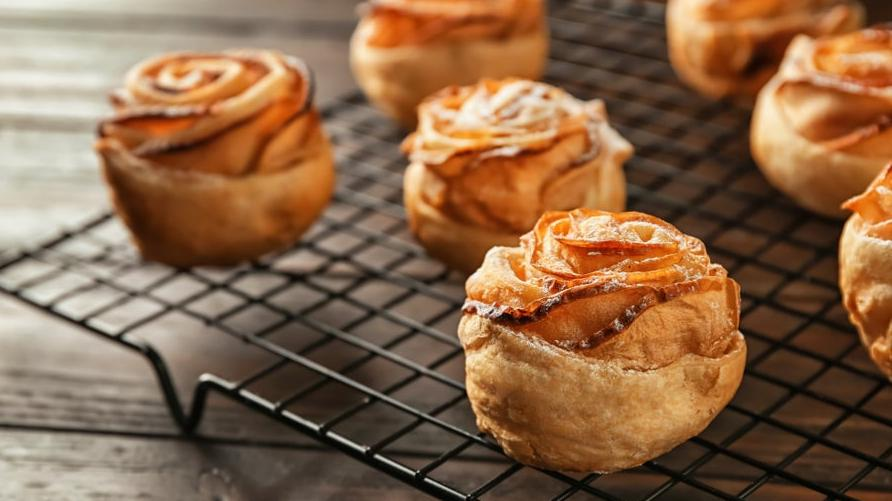These Are The Best Apples For Baking
Start your ovens! It’s apple pie season. And apple crumble season. And apple crisp season.
Fall has fallen, and if you're feeling rustic, you have already donned your flannel button-down, grabbed your wide-brimmed hat, and taken to the fields to enjoy an afternoon of apple picking—perhaps you've even put the (literal) fruits of your labor to work in a few batches of baked goods. Whether you're making pie, tarts, fritters, crisp, or cobbler, apples are one of the most versatile fruits for cooking and baking. However, as you may have noticed when you've eaten a freshly picked apple—especially those newer, flashier apple varieties with trademarked names like Jazz, Cosmic Crisp, and Rave—some are better for snacking "in hand" than others. Let's break down the best types for baking versus the ones that can't take the heat.
What to consider when baking apples
The difference between a good snacking apple and a good baking apple has to do with the thickness and toughness of the skin and flesh.
"While all apple varietals can make for great fall snacking, the texture of the flesh and skin of the apple can determine whether it is better for fresh-eating or to use in baking," says Brianna Shales, Marketing Director at Stemilt Growers.
An apple with thinner skin and more supple (ew) flesh is going to be more fun to eat raw. Meanwhile, apples with thicker skin (which may or may not be peeled off) and denser flesh might not taste as great raw, but hold up well during baking.
If you've ever baked any fruit-filled desserts, you likely already know the trickiest thing about them, which is that the fruits release their juices as they cook. You often have to add cornstarch or another thickening agent to make sure you don't have the dreaded "soggy bottom" often cited on The Great British Baking Show.
The Food Network says to avoid Gala and Red Delicious for baking. Since they have a good amount of juice and are easy to bite, they're more likely to release too much liquid into most crusts or bases, leaving you with a mushy mess.
"When looking for apples to use in pies, or any other cooking or baking recipe, you should choose a varietal with a flesh that can withstand hot oven temperatures," Shales says. "An apple that remains dense during baking is preferred over those that release lots of juice when cooked."
Using the right apples while baking, then, isn't just about finding the right flavor balance. It's about making things easier on yourself, because when an apple releases less liquid into the recipe, you won't have to make modifications to mitigate all that juice.
Try these versatile apple varietals
You don't have to limit yourself to baking with Granny Smith. It turns out that many apples do well in the oven.
Shales points to Pink Lady, Piñata, and Cosmic Crisp as some examples of good baking apples. I can't say that I've tried a Piñata apple—described by Stemilt as having a "crisp, juicy bite" and a "long-lasting pineapple finish"—but the other two are actually my go-to snacking apples. Cosmic Crisp is especially popular with the random children who come to my house and require snacks (my spawn and their friends). It's nice to know I can buy one type of apple and use what I need for baking and then have the leftovers available for eating fresh.
According to Sally's Baking Addiction, a variety of varietals is best, since the mix of flavors and textures makes for a more complex and interesting end product. She also reinforces the conventional wisdom that if you want a tart, green apple for baking, Granny Smith is the one. I don't happen to enjoy these fresh, though my kid who likes sour candy went through a phase of only eating Granny Smiths. Even if you wouldn't snack on one, they do well in desserts that might otherwise be too sweet.
Your apples must be fresh
If you want snacking apples, some varieties are more juicy, and some prioritize that satisfying crunch.
"As for fresh eating apples, the best varietals to give you a satisfying crunch have a flesh that fractures when you bite in and are extra juicy," Shales says.
For juiciness and crunch, she recommends Fuji, Rave, and SweeTango. Rave and SweeTango are trademarked and specifically bred for that tantalizing texture, and they're now available in most grocery stores nationwide. Whichever apples you opt for this year, enjoy them at peak freshness, and keep some lemonade mix on hand just in case they go a little brown.
